-

人音版小学音乐一年级下音的高低说课稿
(3)请学生用自己的声音模拟大钟、小钟,并按节奏谱读谱。(让学生通过歌谣中对大钟、小钟的声音长短的变化,体会大钟和小钟声音高低的特点。教师还要注意提示学生,在读歌谣过程中除了声音要模仿准确,节奏也要模仿准确。)(4)请学生选用乐器来模拟小钟的声音?(踫钟、三角铁)(5)老师用钢琴的低音模拟大钟的声音,其他同学按节奏读谱。教师要求:在教师与学生合作读节奏谱过程中,教师要提示学生:第一,心里要有节奏,速度不能忽快忽慢。第二,没有拿到乐器的同学在读谱过程中,不要忘记模拟大钟、小钟声音的高低。(6)教师与学生合作共同读谱并用乐器模拟大钟、小钟声音。三、课堂小结声音的世界真神奇,有了高低不同、音色不同的神奇声音,把我们的生活装扮得很有趣。今天,我们了解了用“高”、“低”来分辨声音的音色特点。老师给同学们留一个作业,请你试着用声音高低不同的乐器或是动物来创编新歌谣的歌词。
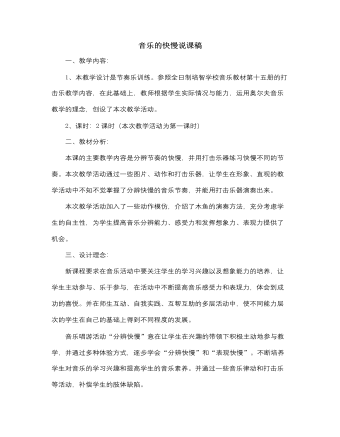
人音版小学音乐一年级下音乐的快慢说课稿
3、用木鱼来演奏音乐的不同节奏。(1)师:小动物们都能听着音乐按节奏走路了,下面我想考考你们能不能用这种乐器来演奏不同的节奏呢。(2) 出示木鱼,演示木鱼的演奏方法。师:左手拿木鱼,右手拿木棍,敲的时候要注意不要打在自己的手指上,打在手指上是没有声音的。(3) 玩游戏《听一听》,训练学生的听辨能力和记忆能力。师:我们先来玩一个游戏,老师敲出几个不同的节奏,你们听听哪个是最慢的,哪个是最快的,看谁的耳朵最灵敏。(4) 学生练习演奏木鱼,学会用木鱼敲出不同的节奏,教师个别指导。师:现在就请同学们自己来演奏木鱼,你可以尝试着怎样敲会快一点,怎样会慢一点。(木鱼学生人手一个)[设计思路]在分层教学过程中,由于个别学生的基础比较差,第一和第二段音乐的演奏训练还不能完全掌握,所以花的时间比较长。导致接下的第三和第四段音乐的木鱼节奏训练没有时间完成。我将在第二课时的复习巩固课上再让同学们来练习演奏。

人音版小学音乐一年级下调皮的小闹钟说课稿
首先听A段主题旋律,我启发学生用声势动作、律动等方式参与到音乐中来,让学生展开丰富的想象力,激发学习兴趣进一步感受音乐里调皮的小闹钟形象。然后在通过演唱A段主题旋律,加深对乐曲的主题记忆,为下一环节做铺垫。在B段主题旋律教学中,我引导学生参与音乐体验,引发想象与联想,采用了律动、打击乐器伴奏、声势活动等形式,通过让学生在闹铃声处使用打击乐器伴奏,模仿闹钟铃响参与音乐体验,不断加强学生对音乐主题的理解与记忆更加深了学生对音乐形象的感受,同时也培养了学生的创造力、表现力和良好的合作意识。第四个环节是参与实践,体验音乐有了前面三个环节的“聆听”,接下来就是有拓展地“聆听”。在这一环节不仅体现了学生的表演欲望,同时也锻炼了学生的表演能力。配合多媒体欣赏学生在听音乐主题A、B部分能准确运用律动、歌唱、声势动作、打击乐器伴奏等形式,同时也培养了学生静听音乐的良好习惯,将课堂气氛推向高潮,学生的学习兴趣、自信心、合作能力等都得了很大的提高。
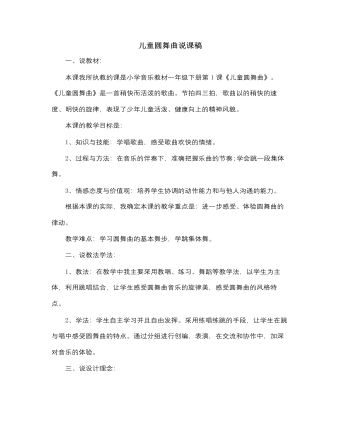
人音版小学音乐一年级下儿童圆舞曲说课稿
本课我采用欣赏《杜鹃圆舞曲》的片断导入新课,挖掘学生已有的对圆舞曲特点的了解,让学生快速进入学习情境,增加学生对圆舞曲学习的兴趣。导入完新课以后,我遵循音乐是听觉的艺术,从聆听入手学唱歌曲,第一次听录音的范唱,让学生聆听音乐,了解歌词的内容。第二次教师有感情的演唱,激发学生听的兴趣,加深学生对歌曲的节拍情绪的理解和感受。在歌曲旋律唱会后,学生自然地就能演唱这首歌曲,知识技能的掌握渗透在歌曲学唱之中。让学生在轻松愉悦的氛围中短时高效的学会歌曲。为了开发学生的创造性潜智,在学会歌曲以后,我设计了舞蹈创编这个教学环节。舞蹈创编就是学生对音乐的再度创作,是发挥学生想象力和思维潜能的学习领域,是学生积累音乐创作经验和发掘创造思维能力的过程和手段,对于培养具有实践能力的创新人才,具有十分重要的意义。让学生的身心、肢体与音乐密切结合,让学生在创编合作中体验快乐,表现快乐。
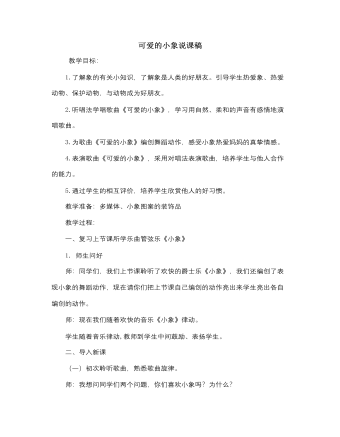
人音版小学音乐一年级下可爱的小象说课稿
师:现在请同学们跟着老师一起朗读歌词。师:我要请两位同学上来,一位同学扮演小朋友,另一位小朋友扮演小象,为我们朗读一次歌词,谁愿意来?学生扮演角色朗读歌词师:你们觉得他们演得好吗?能得多少分?请学生评价,教师总结。(三)编创动作表现歌曲师:如果能加上动作就更好了,现在我们一起来开动脑筋,为这首歌编创动作。在教师的引导下,一句句为歌曲编创动作(四)听唱法学唱歌曲师:我们学会了歌词,还编了动作,当更要学会唱,请同学们跟着老师的琴声学唱歌曲。学生学唱,然后由学生跟着音乐表演歌曲(五)对唱法表演歌曲师:现在我们请1、2组同学扮演小象,3、4组的同学来问小象,我们分角色来表演歌曲。 学生先在原位上演练一遍,然后全体起立,相对而立,表演歌曲。教师作出评价和肯定。三、总结师:今天我们学到了什么学生回答师:今天,我们学习了小象的知识,知道了要与小象成为好朋友,要保护小象和其它动物,学会了表演歌曲《可爱的小象》。
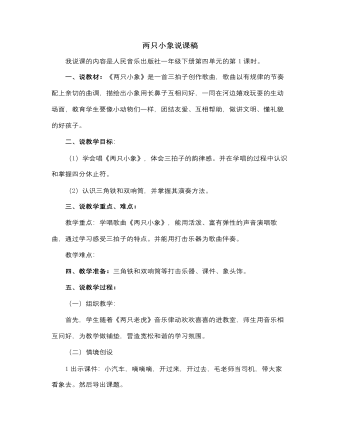
人音版小学音乐一年级下两只小象说课稿
又能再次让学生体会三拍子的韵律感。在配打击乐器为歌曲伴奏这个环节我通过“看图片、找乐器、读节奏、选节奏、敲乐器”等活动充分调动学生学习的积极性,再次掀起学生们的学习乐趣。五、总结:今天我们在动物园和小动物们度过了愉快的一天,我们应爱护小动物,和它们做朋友,而且更要像小动物们一样,团结友爱、互相帮助,做懂礼貌的好孩子。并预告下节课将做象头饰及分小组比赛表演。(在《两只小象》音乐中律动出教室。)总体来说,本方案的设计利用多媒体为学生创设一种生动、直观的教学情景,通过看、听、唱、舞等手段,充分调动了学生的兴趣和积极性,同时在各种音乐活动中,充分体现了学生自主、合作、探究的学习方式,使学生会学、乐学、敢学,将学生自主学习与创新意识的培养落到了实处.
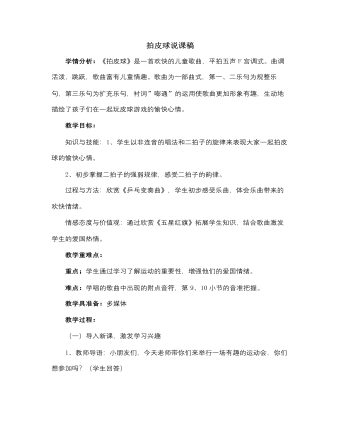
人音版小学音乐一年级下拍皮球说课稿
多媒体反复播放童声齐唱歌曲《五星红旗》,出示歌谱歌词,画面滚动播放各种五星红旗升起的情景以及运动健儿为国争光的一瞬间。(鼓励学生站起来,可以加上拍手的一些动作跟着音乐边唱边体会歌曲情绪,把课堂推向高潮。)师:小朋友们,当国歌再次奏起,看到冉冉升起的五星红旗,我们的心情是多么的激动,我们一起来呼喊”五星红旗,我们的国旗,我们热爱您”(学生跟着老师一起呼喊)。让我们用自己的歌声来表达我们此时的心情吧。设计意图:通过《五星红旗》的欣赏,升华对祖国的热爱之情。(四)总结下课奥运健儿们的那种顽强的奥运精神,坚强的毅力,都是值得我们小朋友一起学习的,我们就从最简单的拍皮球,跳绳开始吧,好好锻炼身体,将来在各种岗位上为国家争光。
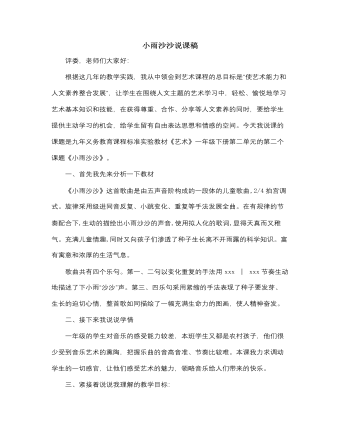
人音版小学音乐一年级下小雨沙沙说课稿
课堂小结部分,我设问“甘甜的雨露滋养种子,帮助种子成长,问学生们喜欢小雨吗?”学生回答后,我进一步诱导:“种子的生长离不开雨水的滋润,你们的成长离不开谁呢?”学生讨论回答(爸爸、妈妈、老师、祖国??)接着教导学生要热爱祖国,孝敬父母,尊敬老师。从现在做起,用优异的成绩来报答他们。 然后对学生这堂课的表现作一个简单的评价,伴随着音乐出教室。最后我总结一下我对这节课的理解和设计。新课改赋予了音乐课五彩缤纷的舞台,给学生的发展提供自由的空间,本课我充分发挥学生的主体作用,让学生成为课堂的主人,让学生在音乐中动起来,给课堂注入新鲜的"血液",让学生徜佯在音乐的世界里自由的发展,并体验到学习音乐的乐趣,真正快乐地享受音乐。 谢谢大家!
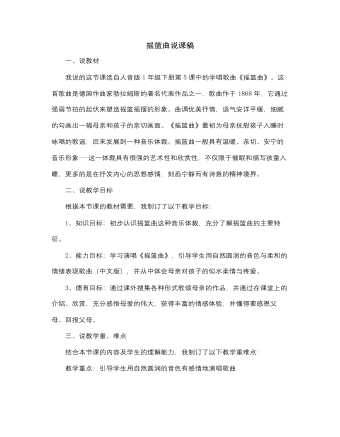
人音版小学音乐一年级下摇篮曲说课稿
先让学生小声跟音乐哼唱,找出自己觉得难唱的乐句以及歌曲中开头与结尾有什么特点。然后再用电子琴带动、结合老师动情的范唱、学生的讨论、尝试来解决歌曲的难点,找到最好的演唱效果。最后引导学生模枋母亲哄孩子睡觉的情景演唱歌曲,让学生在音乐气氛下体会到母亲与孩子的爱深深地融化在一起。3、课外拓展,升华情感。首先欣赏不同国家或民族的《摇篮曲》,揭示《摇篮曲》的音乐特征。通过欣赏不同的摇篮曲,让学生明白《摇篮曲》表达共同的主题,那就是母爱都是伟大的。再进一步了解歌曲的音乐特征。最后一个环节是请学生了解不同形式歌颂母爱的作品,请同学们谈一谈自己的感受。通过本环节教学,引导学生更进一步体会母爱的伟大,让学生用自己的话来表达对母亲的爱。并懂得要感恩父母、回报父母。很好的完成了本节课的德育目标。最后让学生带着对母亲的爱再一次演唱歌曲结束本课。
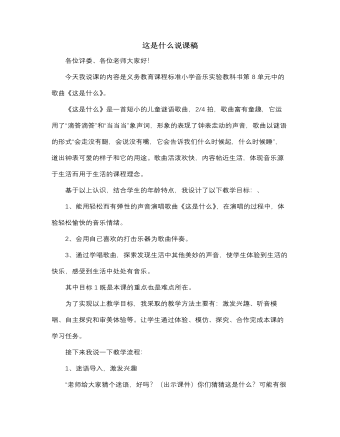
人音版小学音乐一年级下这是什么说课稿
新课标指出,在教学中应注意培养学生自信的演唱,演奏能力及综合性艺术表演能力。我通过举办小小音乐会,把学生分成乐器组和表演组,乐器组的同学使用打击乐为歌曲伴奏,表演组的同学即兴创编动作,让学生在歌表演伴奏教学活动中鼓励学生大胆模仿、想象,培养学生即兴表演能力和人与人这间的合作精神,并让学生在活动中享受美的愉悦,受到情感陶冶,从而把课堂推向高潮。4、深化主题,拓展视野为了拓展学生的音乐视野,深化课堂,我鼓励学生探索和发现生活中其它美妙的声音,(出示课件)“闹钟是我们身边的好朋友,你身边还有哪些能发出响声的好朋友呢?你能不能把他们也变成音乐唱出来呢?”这样让学生感受到生活中处处有音乐,并且挖掘了教材的真正意图,体现音乐课的真正价值。孩子们在歌声中结束了本课的学习,意犹未尽。
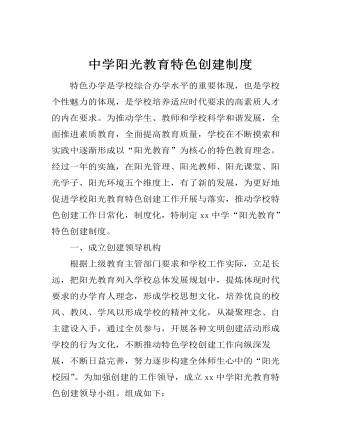
中学阳光教育特色创建制度
一、成立创建领导机构 根据上级教育主管部门要求和学校工作实际,立足长远,把阳光教育列入学校总体发展规划中,提炼体现时代要求的办学育人理念,形成学校思想文化,培养优良的校风、教风、学风以形成学校的精神文化,从凝聚理念、自主建设入手,通过全员参与,开展各种文明创建活动形成学校的行为文化,不断推动特色学校创建工作向纵深发展,不断日益完善,努力逐步构建全体师生心中的“阳光校园”。为加强创建的工作领导,成立xx中学阳光教育特色创建领导小组。组成如下: xx
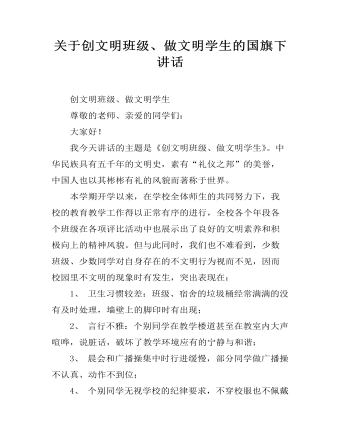
关于创文明班级、做文明学生的国旗下讲话
创文明班级、做文明学生尊敬的老师、亲爱的同学们:大家好!我今天讲话的主题是《创文明班级、做文明学生》。中华民族具有五千年的文明史,素有“礼仪之邦”的美誉,中国人也以其彬彬有礼的风貌而著称于世界。本学期开学以来,在学校全体师生的共同努力下,我校的教育教学工作得以正常有序的进行,全校各个年段各个班级在各项评比活动中也展示出了良好的文明素养和积极向上的精神风貌。但与此同时,我们也不难看到,少数班级、少数同学对自身存在的不文明行为视而不见,因而校园里不文明的现象时有发生,突出表现在:1、 卫生习惯较差:班级、宿舍的垃圾桶经常满满的没有及时处理,墙壁上的脚印时有出现;2、 言行不雅:个别同学在教学楼道甚至在教室内大声喧哗,说脏话,破坏了教学环境应有的宁静与和谐;3、 晨会和广播操集中时行进缓慢,部分同学做广播操不认真、动作不到位
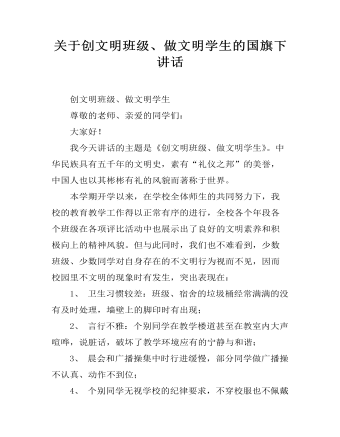
关于创文明班级、做文明学生的国旗下讲话
创文明班级、做文明学生尊敬的老师、亲爱的同学们:大家好!我今天讲话的主题是《创文明班级、做文明学生》。中华民族具有五千年的文明史,素有“礼仪之邦”的美誉,中国人也以其彬彬有礼的风貌而著称于世界。本学期开学以来,在学校全体师生的共同努力下,我校的教育教学工作得以正常有序的进行,全校各个年段各个班级在各项评比活动中也展示出了良好的文明素养和积极向上的精神风貌。但与此同时,我们也不难看到,少数班级、少数同学对自身存在的不文明行为视而不见,因而校园里不文明的现象时有发生,突出表现在:1、 卫生习惯较差:班级、宿舍的垃圾桶经常满满的没有及时处理,墙壁上的脚印时有出现;2、 言行不雅:个别同学在教学楼道甚至在教室内大声喧哗,说脏话,破坏了教学环境应有的宁静与和谐;3、 晨会和广播操集中时行进缓慢,部分同学做广播操不认真、动作不到位;4、 个别同学无视学校的纪律要求,不穿校服也不佩戴校徽;有些同学的头发、服饰等仪容仪表也不符合学校规定。
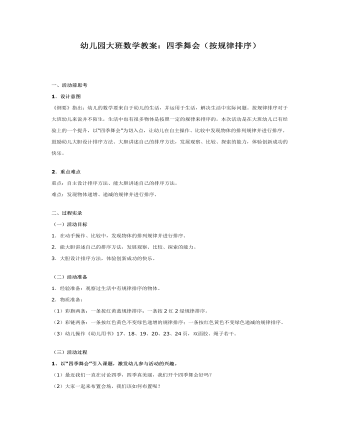
幼儿园大班数学教案:四季舞会
2.重点难点 重点:自主设计排序方法、能大胆讲述自己的排序方法。 难点:发现物体递增、递减的规律并进行排序。 二、过程实录 (一)活动目标 1.在动手操作、比较中,发现物体的排列规律并进行排序。 2.能大胆讲述自己的排序方法,发展观察、比较、探索的能力。 3.大胆设计排序方法,体验创新成功的快乐。 (二)活动准备 1.经验准备:观察过生活中有规律排序的物体。 2.物质准备: (1)彩旗两条:一条按红黄蓝规律排序;一条按2红2绿规律排序。 (2)彩链两条:一条按红色黄色不变绿色递增的规律排序;一条按红色黄色不变绿色递减的规律排序。 (3)幼儿操作《幼儿用书》17、18、19、20、23、24页,双面胶、绳子若干。

新人教版高中英语必修3Unit 1 Festivals and celebrations-Discovering Useful Structure教学设计
4.That was an experience that frightened everyone. →That was _____________________. 答案:1. taking 2. being discussed 3. in the reading room 4. a frightening experienceStep 6 The meaning and function of V-ing as the predicative动词-ing形式作表语,它通常位于系动词后面,用以说明主语“是什么”或“怎么样”一种表示主语的特质、特征和状态, 其作用相当于形容词; 另一种具体说明主语的内容, 即主语等同于表语, 两者可互换。The music they are playing sounds so exciting. 他们演奏的音乐听起来令人激动。The result is disappointing. 结果令人失望。Our job is playing all kinds of music. 我们的工作就是演奏各种音乐。Seeing is believing. 眼见为实。Step 7 Practice1. It is ________(amaze) that the boy is able to solve the problem so quickly.2. Buying a car is simply _______(waste) money. 3. Please stop making the noise—it’s getting ________(annoy). 4. complete the passage with the appropriate -ing form.La Tomatina is a festival that takes place in the Spanish town Bunol every August. I think many food festivals are __________ because people are just eating. however, this festival is _________ because people don't actually eat the tomatoes. Instead, they throw them at each other! the number of people ________ part in this tomato fight, can reach up to 20,000, and it is a very __________ fight that lasts for a whole hour. The _______ thing is how clean Bunol is after the tomatoes are washed away after the fight. this is because the juice form tomatoes is really good for making surfaces clean!答案:1. amazing 2. wasting 3. annoying4. boring interesting taking exciting amazing

新人教版高中英语必修3Unit 1 Festivals and Celebrations-Reading and Thinking教学设计
The topic of this part is “Discover the reasons for festivals and celebrations.The Listening & Speaking & Talking part aims at talking about the experiences and feelings or emotions about the festivals and celebrations. This section aims at detecting the reason why the people celebrate the festivals, the time, the places, the types and the way of celebrations. It also explains why some traditions in the old celebrations are disappearing, like the firecrackers in the big cities and some new things are appearing like the prosperity of business or commerce. 1. Students can talk about what festivals they know and the reasons and the way of celebrating them.2. Students should learn the reading skills such as the headline and get the topic sentences, the structures of articles.3. Students can understand the past, the present situation of some festival around the world and why there are some changes about them. 4. Students can have the international awareness about the festivals.1. Students should learn the reading skills such as the headline and get the topic sentences, the structures of articles.2. Students can understand the past, the present situation of some festival around the world and why there are some changes about them.Step 1 Lead in---Small talkWhat festival do you like best ? Why ?I like the Spring Festivals because I can set off the fireworks, receive the lucky money and enjoy the Gala with my families.Step 2 Before reading---Pair workWhy do people celebrate different festivals ?The Spring Festivals is to celebrate the end of winter and the coming of spring and new life.The Mid-autumn Day is to celebrate the harvest and admire the moon.

新人教版高中英语必修3Unit 1 Festivals and Celebrations-Listening &Speaking&Talking教学设计
The theme of this section is “Talk about festival activities and festival experiences”.Festival and holiday is a relaxing and interesting topic for students. This part talks about the topic from the daily life of students’. In the part A ---Listening and Speaking, there are three conversations among different speakers from three countries(Japan, Rio and China), where the speakers are participating in or going to participate in the festivals and celebrations. So listening for the relationship among them is a fundamental task. Actually, with the globalization and more international communication, it is normal for Chinese or foreigners to witness different festivals and celebrations in or out of China. In the Conversation 1, a foreign reporter is interviewing a Japanese young girl who just had participated in the ceremony of the Coming-of-Age Day on the street and asking her feeling about the ceremony and the afterwards activities. Conversation 2, Chinese girl Li Mei is witnessing the Rio Carnival for the first time, and her friend Carla gives her some advice on the costumes which enables her to match with the carnival to have a good time. Conversation 3, a Chinese guide is showing a group of foreign visitors around the Lantern Festival and introducing the customs of the festival to them. The three conversations have a strong vitality and insert the festival and cultural elements from different countries. So perceiving the festivals and cultures from different countries is the second task. At the same time, the scripts also insert the targeted grammar --- v-ing as attributive and predicative, which students can perceive and experience in a real context and make a road for the further study. That is the third task. In the Part B--- Listening and Talking, the theme is “Talk about festival experience”, which is the common topic in our daily conversations. During the conversation, Song Lin, a Chinese student, asked Canadian friend Max about how to spend Christmas. In the conversation, Song Lin talked about experience and the feelings during the Chinese Spring Festival, during which there are not only some enjoyable things but some unpleasant things. After the listening, perhaps students find there are some similarities between Christmas and the Chinese Spring Festival as there are some differences in the origins and celebrations. For example, people always visit friends and relatives, decorate their houses, have a big dinner together, chat and give presents to each other.

新人教版高中英语必修3Unit 1 Festivals and Celebrations-Reading for writing教学设计二
Step 3 Analyzing article structureActivity 31. Teachers raise questions to guide students to analyze the chapter structure of this diary and think about how to describe the festival experience. (1)What should be included in the opening/body/closing paragraph(s)?(2)How did the writer arrange his/her ideas?(3)What kind of interesting details did the writer describe?(4)How did the writer describe his/her feelings/emotions during the event?2. Students read and compare the three sentence patterns in activity 2. Try to rewrite the first paragraph of the diary with these three sentence patterns. After that, students exchange corrections with their partners. Such as:●This was my first time spending three days experiencing the Naadam Festival in China’s Inner Mongolia Autonomous Region and it was an enjoyable and exciting experience. ●I'll never forget my experience at the Naadam Festival because it was my first time to watch the exciting Mongolian games of horse racing, wrestling, and archery so closely. ●I'll always remember my first experience at the Naadam Festival in China’s Inner Mongolia Autonomous Region because it was so amazing to spend three days witnessing a grand Mongolian ceremony. Step 4 Accumulation of statementsActivity 41. Ask the students to read the diary again. Look for sentences that express feelings and emotions, especially those with the -ing form and the past participle. Such as:● …horse racing, wrestling, and archery, which are all so exciting to watch. ● some amazing performances● I was surprised to see…● I was a little worried about. . . ● feeling really tiredOther emotional statements:●I absolutely enjoyed the archery, too, but the horse races were my favourite part. ●I'm finally back home now, feeling really tired, but celebrating Naadam with my friend was totally worth it. ●He invited me back for the winter to stay in a traditional Mongolian tent and cat hot pot. I can’t wait!2. In addition to the use of the -ing form and the past participle, the teacher should guide the students in the appreciation of these statements, ask them to memorize them, and encourage them to use them reasonably in writing practice.

新人教版高中英语必修3Unit 1 Festivals and Celebrations-Reading for Writing教学设计一
The topic of this part is “Write about your festival experience”.During the Listening and Speaking and Talking, students are just asked to say out their festival experiences such as the Spring Festival, Mid-autumn Day, but this part students will be asked to write down their own festival experiences. During the reading part, it introduces the Naadam Festival in Inner Mongolia Autonomous Region, which can give students a good example to imitate. Students not only learn the festival, but touch and feel the Inner Mongolian’s character, the spirit and cultural atmosphere, which can help students form the cultural awareness and learn to enjoy and value the diversity of Chinese culture.Concretely, the dairy tells the experience that the author spent the Naadam Festival in Inner Mongolia Autonomous Region with his/her friend. The structure is clear. In the opening paragraph, it introduces the topic of the Naadam Festival and the whole feeling. Then it introduces the items of the festival like the ceremony, wrestling and horse racing. Finally, it summarizes this experience. Because this part is a travel journal, we must guide students pay more attention to these details: 1. use the first person. 2. use the past tense to tell the past thing and use the present or future tense to describe the scenery. 3. use the timeline to tell the development. 4. be careful for the author’s psychology, emotion and feeling, etc.1. Read quickly to get main idea; read carefully to get the detailed information about Naadam Festival.2. Learn the structure of the reading article and language.3. Write an article about a festival experience4. Learn to use the psychology, emotions and feeling in the writing.1. Write an article about a festival experience.2. Use the structure of the reading article and language.

新人教版高中英语必修3Unit 2 Morals and Virtues-Discovering Useful Structure教学设计
1. 表示时间。Hearing these stories, I’m skeptical about the place. = When I heard these stories. . . 2. 表示原因。Not knowing his address, I can’t send this book to him. = Because/Since/As I don’t know his address. . . 3. 表示结果。His father died, leaving him a lot of money. =. . . and left him a lot of money4. 表示条件。Going straight down the road, you will find the department store. = If you go straight down the road. . . 5. 表示让步。Being tired, they went on working. =Although they were tired. . . 6. 表示行为方式、伴随情况或补充说明。He lay on the grass, staring at the sky for a long time. =. . . and stared at the sky for a long time注意:非谓语动词作状语时, 如所提供的动词不能和句子中的主语保持一致, 动词-ing形式必须有自己的逻辑主语, 通常由名词或代词来担任, 这就是独立主格结构。The last bus having gone, we had to walk home. (having gone的逻辑主语是the last bus, 而不是we)Weather permitting, the football match will be played on Friday. (permitting的逻辑主语是time, 而不是the football match)Step 7 Practice1. ________(study) hard, you are sure to get first prize. 2. People use plastic in their daily life, _______(leave) large amounts of waste. 3. ________(work) hard at your lessons, you are to succeed. 4. The old man, ____________(work) abroad for twenty years, is on the way back to his motherland. 5. ______________(finish) his homework, he was playing on the playground. Answers: 1. Studying 2. leaving 3. Working 4.having worked 5. Having finishedStep 8 HomeworkFinish the homework on Page 22.

